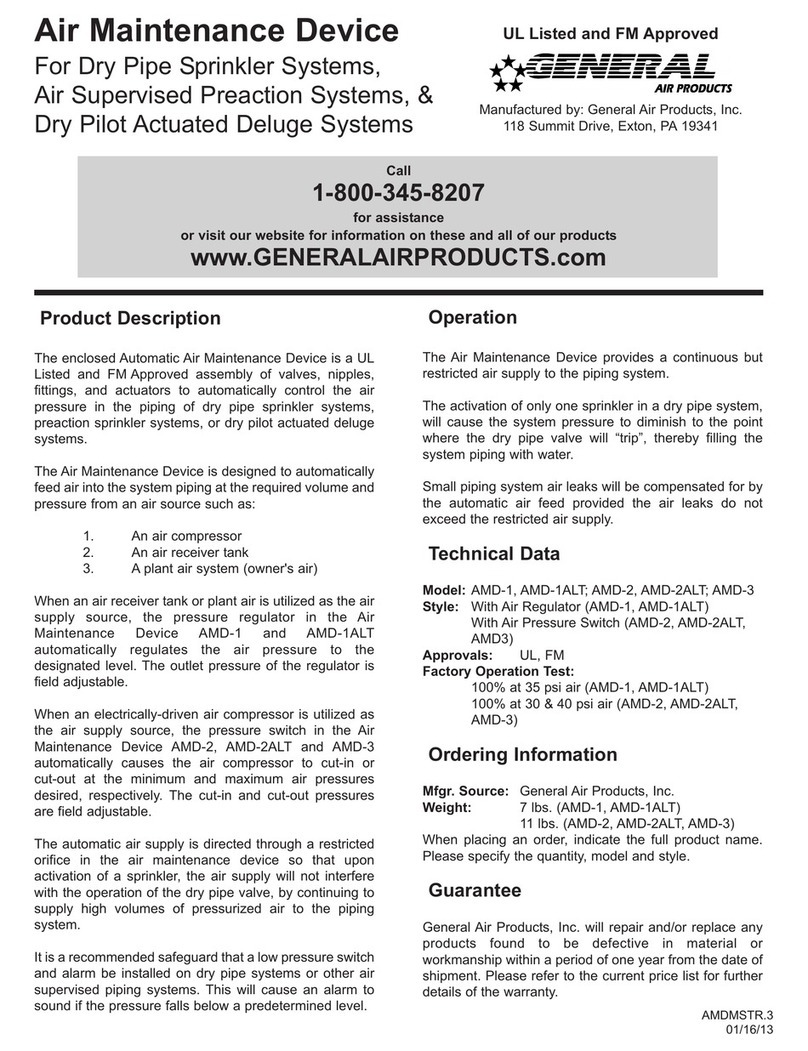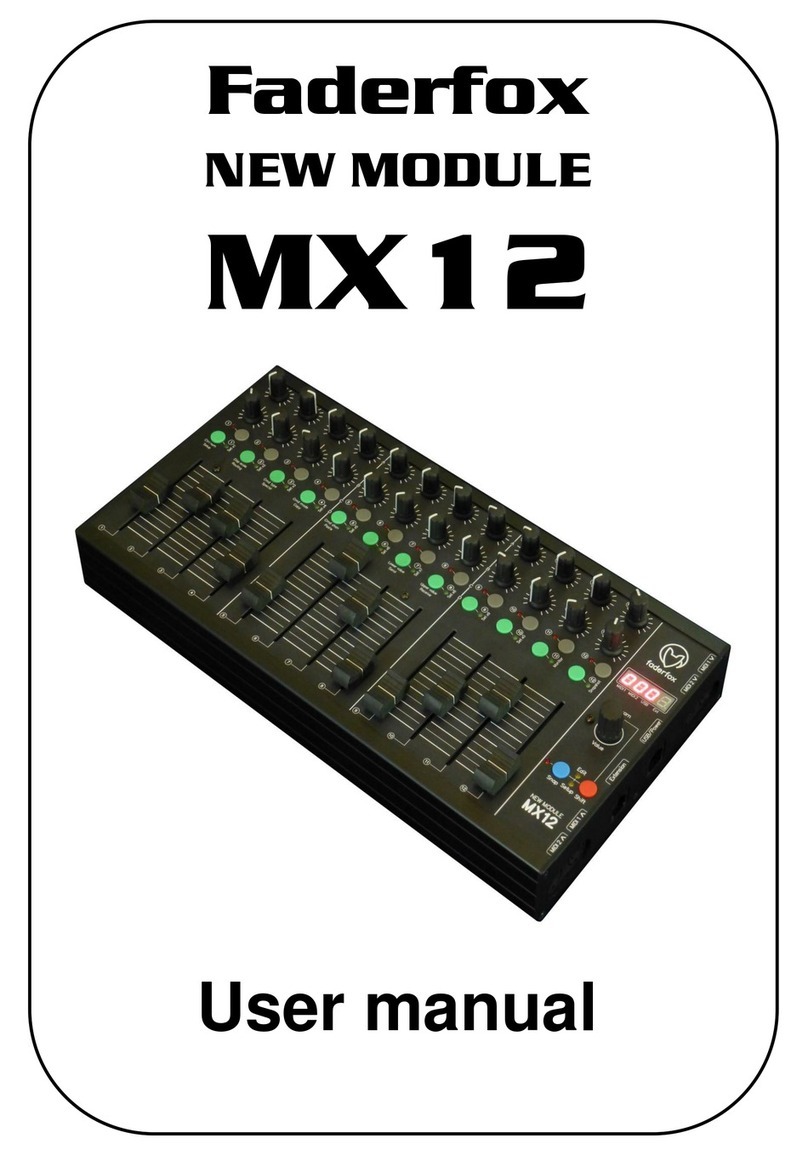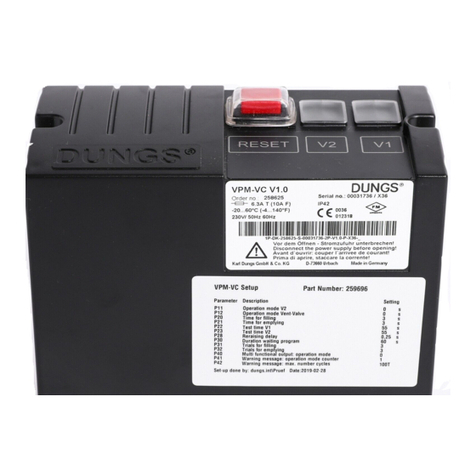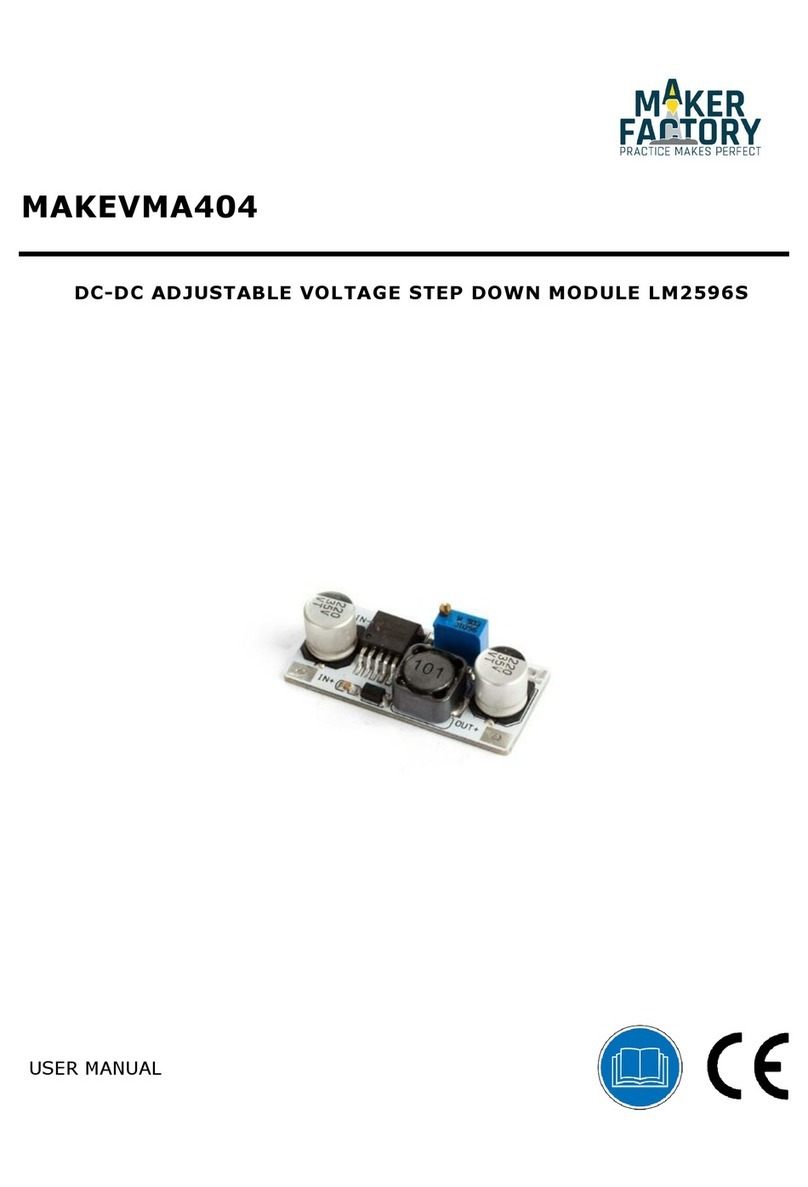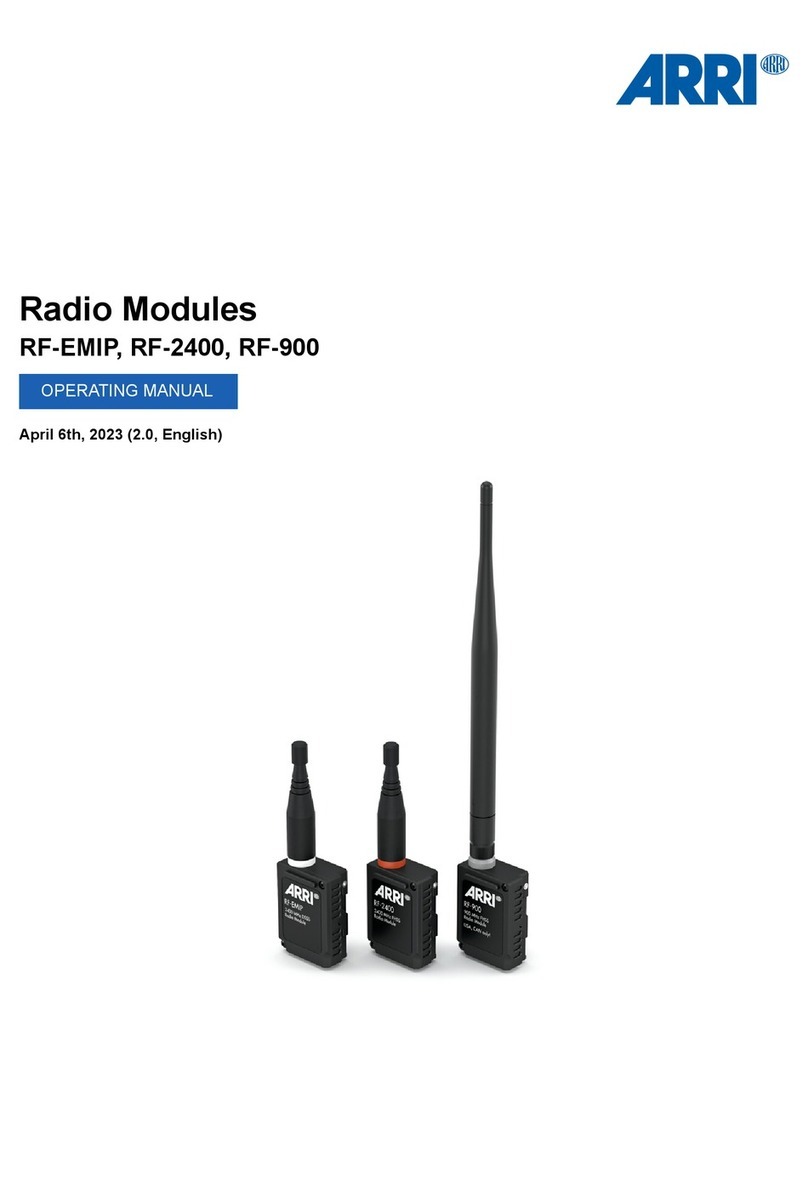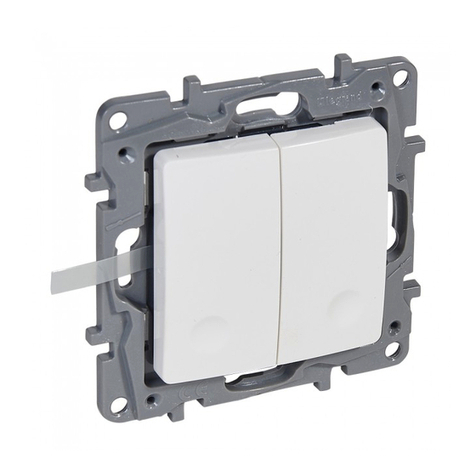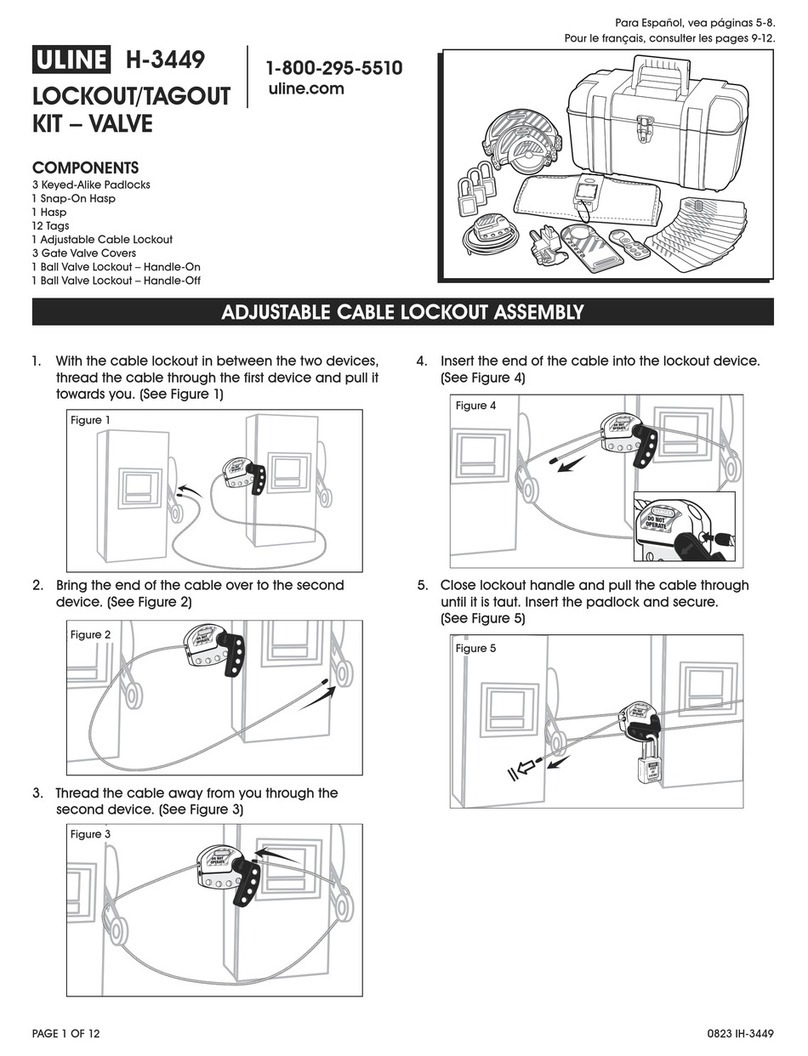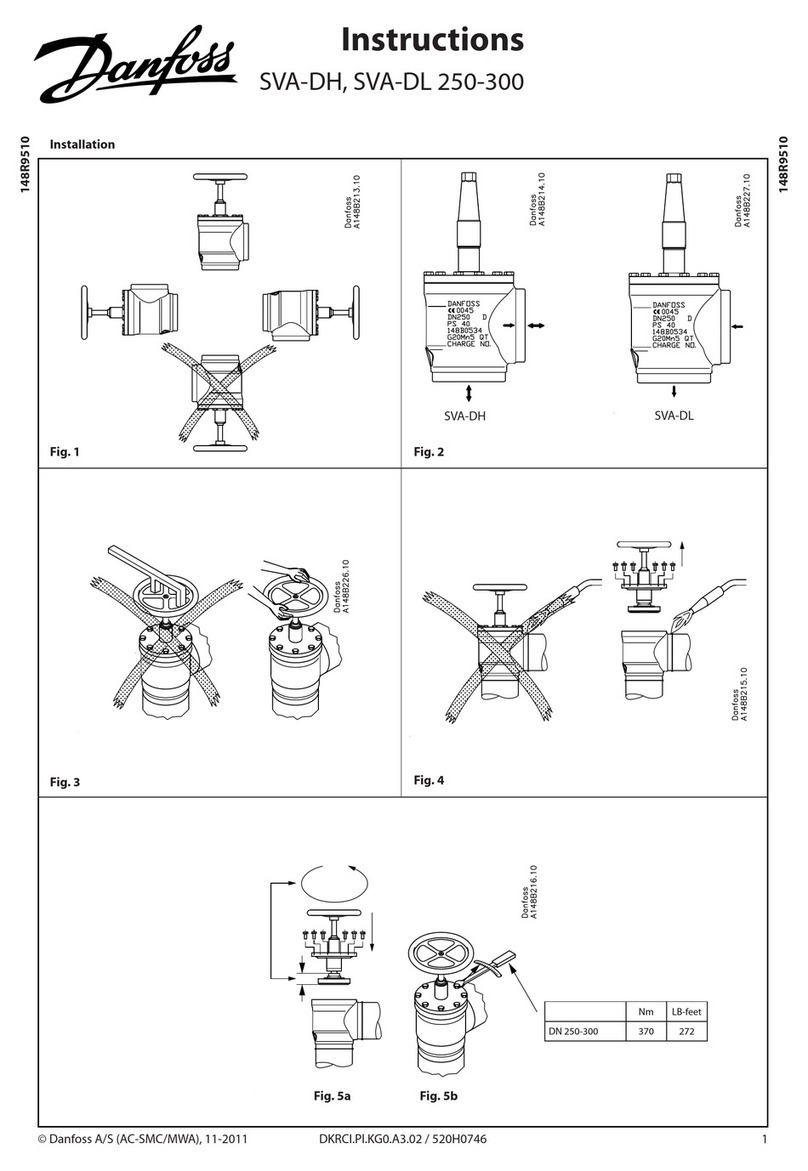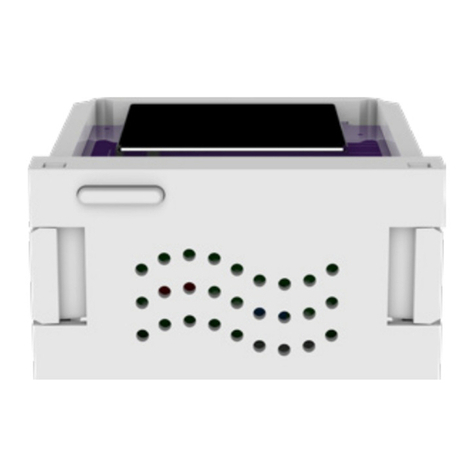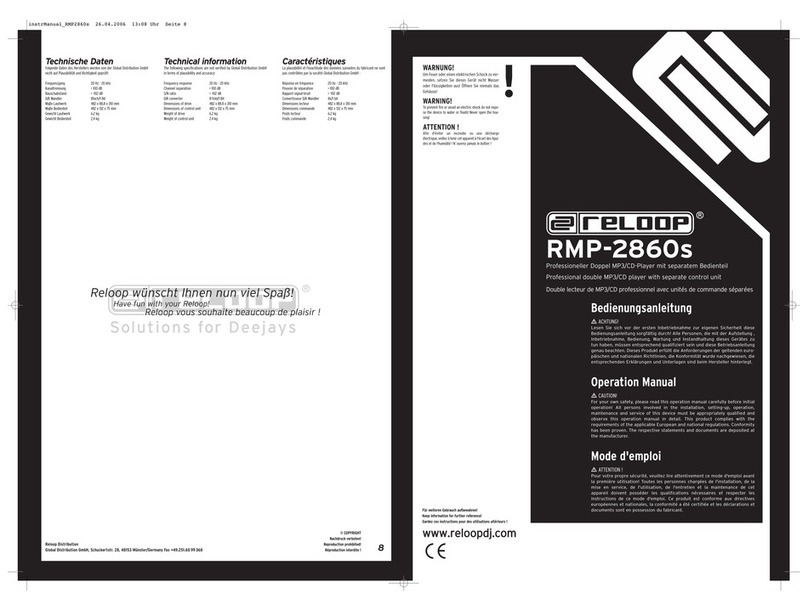General Air Products NGP-APV User manual

1
Call 1-800-345-8207
or visit our web site for our complete product listing
www.GeneralAirProducts.com
Rev. 1, 12-23
Pre device n gas monitoring port installed at the end of the piping system to provide a means
to lee oyen rom te sprinkler pipin rin te nitroen ill proess n analyzethe gas purity
of the entirepiping system. Used in conjunction with the PPS portle s analyzer sol
it te itroen enertor at the gas source,te pre le provides a simple and reliable way
to monitor the gas purity throughout te sprinkler system,and purge oxygen from the piping.
Licensed for use under U.S. Patents 9,144,700, 9,186,533, and 9,610,466
Purge Vent / Sampling Port
or se it ire Protetion itroen enertors on Dry Pipe Sprinkler Systems
Models: NGP-APV / NGP-PV-1
Installation, Operationand Maintenance Manual

2
Basic Components
Installation and Operation Instructions
Locations to Install Purge Valve
1. As directed by the system design engineer.
2. On the end of the most distant sprinkler pipe in the upper story.
3. In a location which is readily accessible for manual actuation and future inspection.
4. In a spot where upstream plumbing will not trap water.
5. One purge valve should be installed on the end of each sprinkler system being fed by the nitrogen
generator.
Installing
The NGP-PV-1 Purge Valve assembly is comprised of a ½” manual ball valve, hex exhauster
orifice, gas analyzer port, and quick connect cap to close the system. The NGP-APV Purge Valve
includes these components as well as a battery operated automatic valve with a 2-week timer.
Ensure the purge valve is vertical (plumb) when the installation is finished.
1. Apply appropriate pipe sealant and install using a wrench on the flats. The outlet must be
pointed to the ceiling
2. Close the manual ball valve until the nitrogen generation system has been integrity tested and is
ready to be brought on line.
3. To start initial system commissioning, remove the quick connect cap and open the manual ball
valve to begin the purging process.
4. If using the NGP-APV, a new 9-volt battery must be inserted into the battery compartment.
Move the slide switch to the “OPEN VALVE” position to begin the purging process and start the
2-week timer. The valve will automatically close after the 2-week timer has elapsed. The LED
indicator will reflect the status of the valve. To close the valve at any time, move the slide switch
to the “CLOSE VALVE” position.

3
Operating
1. Monitoring
a. If not already connected, attach the gas analyzer using the quick-disconnect.
b. Ensure the manual ball valve is open. If using the NGP-APV, insert a new 9-
volt battery and move the slide switch to the open position.
c. Turn the gas analyzer on and wait 30 seconds before reading the
concentration.
d. The gas analyzer should remain in place with the purge valve open until the
desired purity level is obtained. Turn the analyzer off.
e. Weekly readings of the gas analyzer should be made to ensure the piping
system has the desired gas purity. When the desired purity is obtained, turn
the gas analyzer OFF, close the purge valve and replace the quick connect
cap. Follow “Sampling” instruction below for monthly nitrogen purity checks.
f. The gas analyzer may remain in place indefinitely if there is no threat of
freezing conditions; if freezing temperatures are possible the gas analyzer
should be stored in a conditioned environment until needed. IF BELOW
FREEZING TEMPERATURES ARE A POSSIBILITY, THE GAS ANALYZER MUST BE
DISCONNECTED, MOVED TO AND STORED IN A WARMER LOCATION.
2. Sampling and Purging
a. Connect the gas analyzer to the quick-disconnect.
b. Ensure the manual ball valve is open. If using the NGP-APV, insert a new 9-
volt battery and move the slide switch to the open position to allow purging,
and sampling.
c. Follow the instructions of the gas analyzer to take a concentration reading.
d. Disconnect when finished and store gas analyzer in an area not subject to
freezing.
e. Close purge valve to finish sampling or to stop purging, purging will take 2 to
3 weeks to reach 98% nitrogen for the typical system.
f. To close system when not purging or sampling: Place quick connect cap onto
valve by pulling back on cap sleeve and releasing when plug is fully inserted
into cap.
NGP-APV
WITH ANALYZER ATTACHED
1. During a system trip test or while the system is depressurized, unthread the NGP-PV-1 valve and the
hex exhauster. DO NOT attempted to inspect these components while the system is operational.
Doing so will be hazardous and trip the system.
2. Examine the inlet screen to the NGP-PV-1 valve. Clean as needed by removing its retaining ring with
snap ring pliers.
3. Examine the inlet screen to the hex exhauster. The exhauster will need to be replaced if it or the
screen is blocked.
4. When completed, reconnect all components with appropriate pipe sealant on all joints which were
disturbed.
Troubleshooting
If a blockage is suspected in the hex exhauster orifice, inspect its filter screen and the valve inlet screen during the
system trip test or while the system is depressurized.

4
NGP-PV-1 (Manual Purge Valve) General Arrangement
NGP-APV (Automatic Purge Valve) General Arrangement
NOTES:
• VALVE REQUIRES A 9 VOLT BATTERY TO OPERATE
• TO OPEN THE VALVE AND BEGIN THE TWO WEEK TIMER, SLIDE THE SWITCH TO THE
"OPEN VALVE" POSITION
• TO CLOSE THE VALVE, SIMPLY SLIDE THE SWITCH TO THE "CLOSE VALVE" POSITION
• IF BATTERY VOLTAGE IS TOO LOW, THE LED WILL FLASH RED WHEN ATTEMPTING
TO OPEN THE VALVE.

5
NGP-PSN2 Portable Gas Analyzer (sold separately)
Operating Instructions for Use
CLASSIFICATION
Protection against electric shock: . . . . . . . . . . . . . . . . . . . . . . . . . . Internally powered equipment.
Protection against water: . . . . . . . . . . . . . . . . . . . . . . . . . . . . . . . . . . . . . . . . . . . . . . . . . . . . IPX1
Mode of Operation: . . . . . . . . . . . . . . . . . . . . . . . . . . . . . . . . . . . . . . . . . . . . . . . . . . . Continuous
Flammable anesthetic mixture:. . . . . . . . . . . . . . . . . . . . . . . . Not suitable for use in presence of a
flammable anesthetic mixture
Product Disposal Instructions:
The sensor, batteries, and circuit board are not suitable for regular trash disposal.
Return sensor to General Air Products for proper disposal or dispose according to local
guidelines. Follow local guidelines for disposal of other components.
WARRANTY
The N2 analyzer is designed for oxygen delivery equipment and systems. Under normal
operating conditions, we warrant the N2 analyzer to be free from defects of workmanship or
materials for a period of 1- year from the date of shipment provided that the unit is properly
operated and maintained in accordance with our operating instructions. Based on our product
evaluation our sole obligation under the foregoing warranty is limited to making replacements,
repairs, or issuing credit for equipment found to be defective. This warranty extends only to the
buyer purchasing the equipment directly from us or through our designated distributors and
agents as new equipment. Our warranty warrants the oxygen sensor in the N2 analyzer to be
free from defects in material and workmanship for a period of 1-year from the date of
shipment in a N2 analyzer. Should a sensor fail prematurely, the replacement sensor is
warranted for the remainder of the original sensor warranty period. Routine maintenance
items, such as batteries, are excluded from warranty. We and any other subsidiaries shall not
be liable to the purchaser or other persons for incidental or consequential damages or
equipment that has been subject to abuse, misuse, mis-application, alteration, negligence or
accident.
These warranties are exclusive and in lieu of all other warranties, expressed or implied,
including warranty of merchantability and fitness for a particular purpose.

6

7
INTRODUCTION
The following instructions describe the function; operation and maintenance of the N2 Analyzer. The N2
analyzer is engineered for long life, maximum reliability and stable performance.
NOTE: In order to obtain optimum performance from your analyzer, all operation and maintenance
must be performed in accordance with these instructions. Please read these instructions thoroughly
before using the analyzer and do not attempt any repair or procedure that is not described herein. We
cannot warranty any damage resulting from misuse, unauthorized repair or improper maintenance of
the instrument.
N2 ANALYZER FEATURES AND FUNCTIONS
LCD Display: A 3-digit display provides a direct readout of nitrogen concentration in the range of 0 -
99.9%.
ON Button/Auto OFF: Use this button to turn the N2 Analyzer on or off.
Over Range Indicator: The appearance of a decimal point after the first digit means that the N2 Analyzer
is reading in excess of 99.9%. Recalibrate analyzer when over range is indicated.
Example: 0.0.0 = 100% 0.0.1 = 101%
0.0.2 = 102% (etc).
Calibration Key: This key is used to calibrate the device. Holding the key for more than three seconds
will force the device to enter a calibration mode.
Oxygen Sensor: This is used to measure oxygen concentration in sample gas.
Sample Inlet Connection: This is the port at which the device is connected to determine nitrogen
concentration.
PRE-USE CHECKOUT/CALIBRATION
Follow these steps before using the N2 Analyzer:
1. Remove N2 Analyzer from box.
2. Unscrew the N2 Analyzer from the black connector body.
3. Using the "ON/OFF" key , make sure the unit is in the power "ON" mode.
4. Press and hold the Calibration Key , for 3 seconds until the display reads "CAL". This will calibrate
the N2 Analyzer to room air. The display will read 79.1%. Thereafter, we recommend calibration on
a weekly basis.
5. Thread the oxygen sensor back onto the black connector body.
6. N2 Analyzer is ready for use.

8
A new calibration is required when:
• The measured N2 percentage in 79.1% N2 is above 80.1% N2
• The measured N2 percentage in 79.1% N2 is below 78.1% N2
• If you are unsure about the displayed N2 percentage. (see Factors influencing accurate readings.)
OPERATION PRINCIPALS
The instrument display corresponds directly to the oxygen sensor. The oxygen diffuses through the
membrane and an electrical current is generated that is proportional to the partial pressure of oxygen in
the gas sample. The oxygen percentage is subtracted from 100, with the remainder being displayed as
percent nitrogen. The sensor has a minimal response to gases other than oxygen.
FACTORS INFLUENCING ACCURATE READINGS
Elevation Changes
• Changes in elevation result in a reading error of approximately 1% increase of reading per 250 feet
increase in elevation.
• In general, calibration of the instrument should be performed when elevation at which the product is
being used changes by more than 500 feet.
Temperature Effects
The N2 analyzer will hold calibration and read correctly within ±3% when in thermal equilibrium within
the operating temperature range. The device must be thermally stable when calibrated and allowed to
thermally stabilize after experiencing temperature changes before readings are accurate.
• For best results, perform the calibration procedure at a temperature close to the temperature where
analysis will occur.
• Allow adequate time for the sensor to equilibrate to a new ambient temperature.
CAUTION: "CAL Err St" may result from a sensor that has not reached thermal equilibrium.
Pressure Effects
Readings from the N2 analyzer are proportional to the partial pressure of oxygen. The partial pressure is
equal to the concentration times the absolute pressure. Thus, the readings are proportional to the
concentration if the pressure is held constant. Therefore, the following are recommended:
Humidity Effects
Humidity (non-condensing) has no effect on the performance of the N2 analyzer other than diluting the
gas, as long as there is no condensation. Depending on the humidity, the gas may be diluted by as much
as 4%, which proportionally reduces the oxygen concentration. The device responds to the actual
oxygen concentration rather than the dry concentration. Environments where condensation may occur
are to be avoided since moisture may obstruct passage of gas to the sensing surface, resulting in
erroneous readings and slower response time. For this reason, the following is recommended:
• Avoid usage in environments greater than 95% relative humidity.
• Calibrate the N2 analyzer at atmospheric pressure.
•Do not block holes in barbed fitting, or pressurize sensor over two atmospheres.

9
CALIBRATION ERRORS AND ERROR CODES
The N2 analyzers have a self-test feature built into the software to detect faulty calibrations, oxygen sensor
failures, and low operating voltage. These are listed below, and include possible actions to take, if an error code
occurs.
E03: No valid calibration data available
Make sure unit has reached thermal equilibrium. Press and hold the
Calibration Button for three seconds to manually force a new calibration.
E04: Battery below minimum operating voltage
Change batteries.
CAL Err St: O2 Sensor reading not stable
Wait for displayed oxygen reading to stabilize when calibrating the device at 100% oxygen. Wait for unit to reach
thermal equilibrium (Please note that this can take up to one half hour, if the device is stored in temperatures
outside the specified operating temperature range).
CAL Err lo: Sensor voltage too low
Press and hold the Calibration Button for three seconds to manually force a new calibration. If unit repeats
this error more than three times, contact General Air Products Customer Service for possible sensor
replacement. CAL Err hi: Sensor voltage too high
Press and hold the Calibration Button for three seconds to manually force a new calibration. If unit repeats
this error more than three times, contact General Air Products Customer Service for possible sensor
replacement. CAL Err Bat: Battery voltage too low to recalibrate
Change batteries.
Changing the Batteries
When the batteries need to be changed, the device will indicate this in one of two ways:
1. The battery icon on the bottom of the display will begin to flash. This icon will continue to flash until the
batteries are changed. The unit will continue to function normally for approx. 200 hours.
2. If the device detects a very low battery level, an error code of “E04” will be present on the display, and
the unit will not function until the batteries are changed. To change the batteries, begin by removing the
three screws from the back of the device. A #1 phillips screwdriver is
required to remove these screws. Once the screws are removed, gently separate the two halves of the
device. The batteries can now be replaced from the back half of the case. Be sure to orient the new
batteries as indicated in the embossed polarity on the back case. NOTE: If the batteries are installed
incorrectly the batteries will not make contact and the device will not operate. Carefully, bring the two
halves of the case together while positioning the wires so they are not pinched between the two case
halves. The gasket separating the halves will be captured on the back case half. Reinsert the three screws
and tighten until the screws are snug. The device will automatically perform a calibration and begin
displaying % of nitrogen.
HELPFUL HINT: If unit does not function, verify that the screws are tight to allow proper electrical
connection.

10
Changing the Oxygen Sensor
Should the oxygen sensor require changing, the device will indicate this by presenting “Cal Err lo”
on the display after initiating a calibration.
To change the oxygen sensor, begin by removing the three screws from the back of the device. A #1
Phillips screwdriver is required to remove these screws. Once the screws are removed, gently
separate the two halves of the device. Disconnect the oxygen sensor from the printed circuit board
by pressing the unlock lever first and then pull the connector out of the receptacle. The oxygen
sensor can now be replaced in the back half of the case.
HELPFUL HINT: Be sure to orient the new sensor by aligning the red arrow on the sensor with the
arrow in the back case. A small tab is located on the back case that is designed to engage the
sensor and prevent it from rotating within the case.
NOTE: If the oxygen sensor is installed incorrectly, the case will not come back together and the unit
may be damaged when the screws are reinstalled. Reconnect the oxygen sensor to the connector
on the printed circuit board. Carefully bring the two halves of the case together while positioning
the wires to ensure they are not pinched between the two case halves. Make sure the sensor is fully
inserted and in the proper orientation. Reinsert the three screws and tighten until the screws are
snug. Verify the unit operates properly. The device will automatically perform a calibration and
begin displaying % of nitrogen.
CLEANING, MAINTENANCE, AND DISPOSAL
Store the N2 analyzer in a temperature similar to its ambient environment of daily use. The
instructions given below describes the methods to clean the instrument, sensor and its accessories
• The threaded black body adapter may be cleaned by washing it with a 65% alcohol / water solution.
The part must be thoroughly dry before it is re-used.
• Clean the sensor with a cloth moistened with a 65% alcohol / water solution.
• We do not recommend use of spray disinfectants because they can contain salt, which can
accumulate in the sensor membrane and impair readings.
Do not throw away. Dispose of properly in accordance with local regulations.
Oxygen Sensor
• When cleaning or disinfecting the exterior of the N2 analyzer, take appropriate care to prevent any
solution from entering the instrument. Do not immerse unit in fluids.
Instrument
Accessory

11
SPECIFICATIONS
Analyzer Specifications
Sensor Type: . . . . . . . . . . . . . . . . . . . . . . . . . . . . . . . . . . . . . . . . . . . . . . . .. . . . . . . . . . . Galvanic fuel cell
Measurement Range: . . . . . . . . . . . . . . . . . . . . . . . . . . . . . . . . . . . . . . .. . . . . . . . . . . . . 0-99.9% Nitrogen
Resolution/Display: . . . . . . . . . . . . . . . . . . . . . . . . . . . . . . . . . . . . . . . . . . . . . . . . . . . . . . . . . . . . . . . . 0.1%
The three digit LCD indicates values between 0.0 - 99.9% oxygen.
Over range indicated by one decimal point on display located after the first digit.
Accuracy and Linearity: . . . . . . . . . . . . . . . . . . . . . . . . . ± 1% of full scale at constant temperature, R.H.
and @ 15°C - 40°C pressure when calibrated at full scale.
± 3% actual oxygen level over full operating temperature.
Response Time: . . . . . . . . . . . . . . . . . . . . . . . . . . . . . . . . . .< 15 seconds for 90% step change. (at 25°C)
Warm-up Time: . . . . . . . . . . . . . . . . . . . . . . . . . . . . . . . . . . . . . . . . . . . . . . . . . . . None required Operating
Temperature: . . . . . . . . . . . . . . . . . . . . . . . . . . . . . . . . . . . . . . . . . . . . . . . . . . . . 15°C - 40°C (59°F - 104°F)
Storage Temperature: . . . . . . . . . . . . . . . . . . . . . . . . . . . . . . . .. . . . . . . . . . . . . . .-15°C - 50°C (5°F - 122°F)
Operating Pressure: . . . . . . . . . . . . . . . . . . . . . . . . . . . . . .. . . . . . . . . . . . . Atmospheric pressure to 3psig.
Environmental: . . . . . . . . . . . . . . . . . . . . . . . . . . . . . . . General purpose housing equivalent to NEMA 1.
The N2 Analyzer is not waterproof. 0-95% RH, non-condensing.
Warranty: . . . . . . . . . . . . . . . . . . . . . . . . . . . . . . . . . . . . Twelve months in normal operating conditions.
Power Requirements: . . . . .. . . . . . . . . . . . . . . . . . . . . . . . . . .Powered by one internal, non-replaceable
Electronics rated general purpose;
not for use in hazardous areas or for
use with flammable gases.
Weight:. . . . . . . . . . . . . . . . . . . . . . . . . . . . . . . . . . . . . . . . . . . . . . . . . . . . . . . . . . . . . . . . Approx. 3 Ounces
Battery Life: . . . . . . . . . . . . . . . . . . . . . . . . . . . . . . . . . . . . . . . . . . . . . Approx. 5000 hours continuous use
Sample Port: . . . . . . . . . . . . . . . . . . . . . . . . . . . . . . . . . . . . . M16 x1 Thread with barbed tubing adapter.
Operating Pressure: . . . . . . . . . . . . . . . . . . . . . . . . . . . . . . . . . . . . . . . . . . . Atmospheric pressure to 3 psig
Expected Storage Life: . . . . . . . . . . . . . . . . . . . . . . . . . . . . . . . Two months with freshness seal on sensor.

Warranty Policy
GR RV
General ir rocts nc. the oan arrants to each original
rchaser rchaser o its ne rocts ro the oan or
its thorie istribtor that sch rocts are at the tie o e
liver to the rchaser ae ith goo aterials an oranshi.
o arrant is ae ith resect to:
1. n roct hich has been reaire or altere in sch
a a in the oanies gent as to aect the
roct aversel.
. n roct hich has in the oanies gent
been sbecte to negligence accient iroer
storage iroer installation or alication.
. n roct hich has not been oerate or
aintaine in accorance ith the recoenations o
the oan.
4. oonents or accessories anactre
arrante an service b others.
. n reconitione or rior one roct.
lais or ites escribe in 4. above shol be sbitte
irectl to the anactrer o the coonent or accessor.
WRR R
he oans obligation ner this Warrant is liite to reair
or at its otion relacing ring noral bsiness hors at the es
ignate acilit o the oan an art that in its sole gent
rove not to be as arrante ithin the alicable Warrant erio
as ollos.
ll nonconsable coonents are arrante or 1 onths ro
the ate o rchase or 1 onths ro ate o anactre hich
ever occrs irst. onsables are not covere ner arrant. he
nit st have been installe b either a actor athorie istrib
tor or agent in accorance ith the actor recoenations ta
ing into accont all other local site conitions not originall note to
the actor. he nit st be oerate an aintaine in accor
ance ith the actor recoenations an original esign con
itions. ailre to rovie sch roo o the above a voi
arrant.
R RR
he oan ill reair or relace an roct or art thereo
hich in the oans sole geent is eective in aterial or
oranshi. abor costs are not covere ner arrant.
ll costs o transortation o roct labor or arts claie not to
be as arrante an o reaire or relace arts to or ro actor
shall be borne b rchaser. he oan a reire the retrn
o an art claie not to be as arrante to one o its acilities as
esignate b the oan transortation reai b rchaser
to establish a clai ner this arrant.
Relaceent arts rovie ner the ters o the arrant are
arrante or the reainer o the Warrant erio o the roct
on hich installe to the sae etent as i sch arts ere orig
inal coonents or or 0 as hichever is longer.
R
RGG WRR V
R GR
R WRR R R
R R G WR
R R R.
R RV R WRR
V R V
RR
R G R .
R R
R R R
G R
WVR .
o stateent reresentation agreeent or nerstaning oral or
ritten ae b an agent istribtor reresentative or eloee
o the oan hich is not containe in this Warrant ill be bin
ing on the coan nless ae in riting an eecte b an
oicer o the oan.
his arrant shall not be eective as to an clai hich is not re
sente ithin 0 as ater the ate on hich the roct is
claie not to have been as arrante. n action or breach o this
arrant st be coence ithin one ear ater the ate on
hich the case o action occrre.
n astent ae rsant to this arrant shall not be con
stre as an aission b the oan that an roct as not
as arrante.
R RR
he oan ill ae a goo aith eort or rot correction or
other astent ith resect to an roct hich roves to be
eective ithin the arrant erio. eore retrning an roct
rite or call the istribtor agent or athorie coan ro hich
the roct as rchase escribing eect an giving ate an
nber o original invoice a ell as roo o actor slie con
sables an roo o schele aintenance. o rocts ill be
accete or retrn ithot the oan issing a Retrne Goos
thoriation RG to the rchaser an nless accoanie b
a roerl athorie RG reest or initiate b the rchaser.
Retrn reight st be reai an each retrne roct st
have the RG nber clearl are on the roct. itle an ris
o loss ass to ber on eliver to the coon carrier.
R
an tates ocalities an ontries have coes an reglations
governing sales constrction installation anor se o rocts
or certain roses hich a var ro those in neighboring
areas. While General ir rocts nc. attets to assre that its
rocts col ith sch coes it cannot garantee coliance
an cannot be resonsible or ho the roct is installe or se.
eore rchase an se o a roct lease revie the roct
alication an national an local coes an reglations an be
sre that the roct installation an se ill col ith the.
General Air Products, Inc.
11 it rive
ton 141
800-345-8207 2
This manual suits for next models
1
Table of contents
Other General Air Products Control Unit manuals
Popular Control Unit manuals by other brands
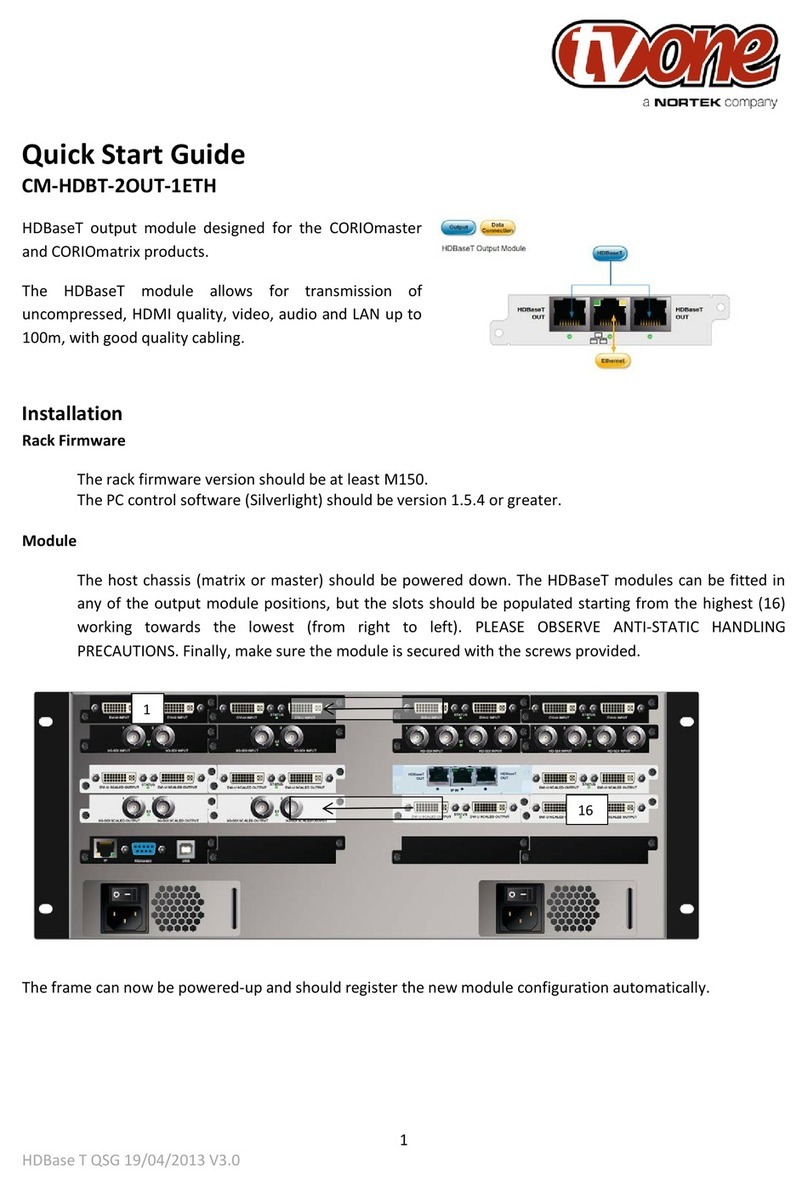
Nortek
Nortek tvone CM-HDBT-2OUT-1ETH quick start guide
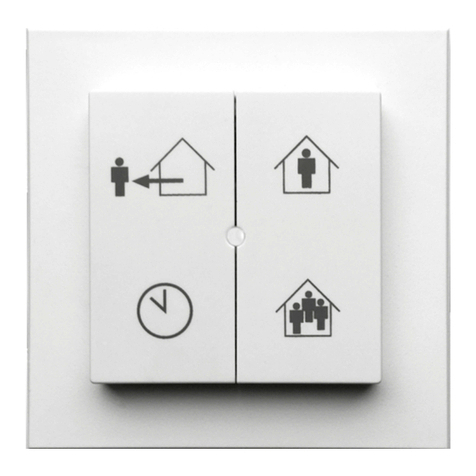
CALEFFI
CALEFFI AIR190001 manual
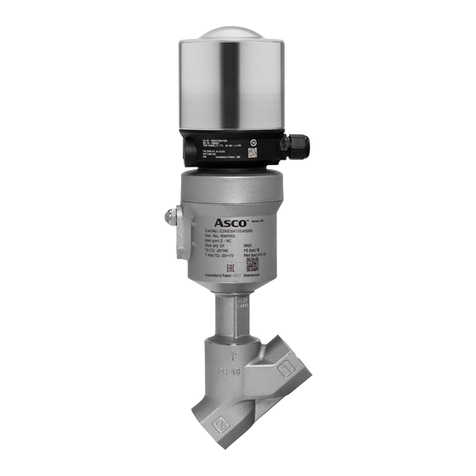
Emerson
Emerson ASCO 290 Series Installation and maintenance instructions
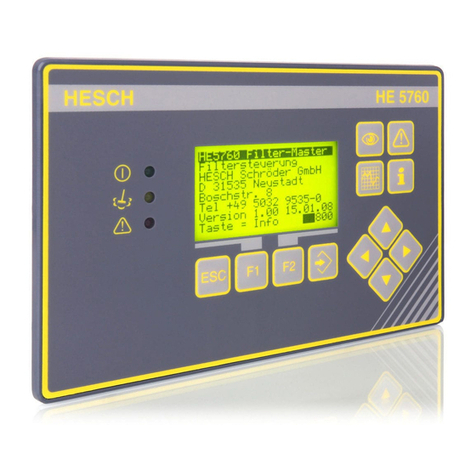
HESCH
HESCH HE 5760 operating instructions
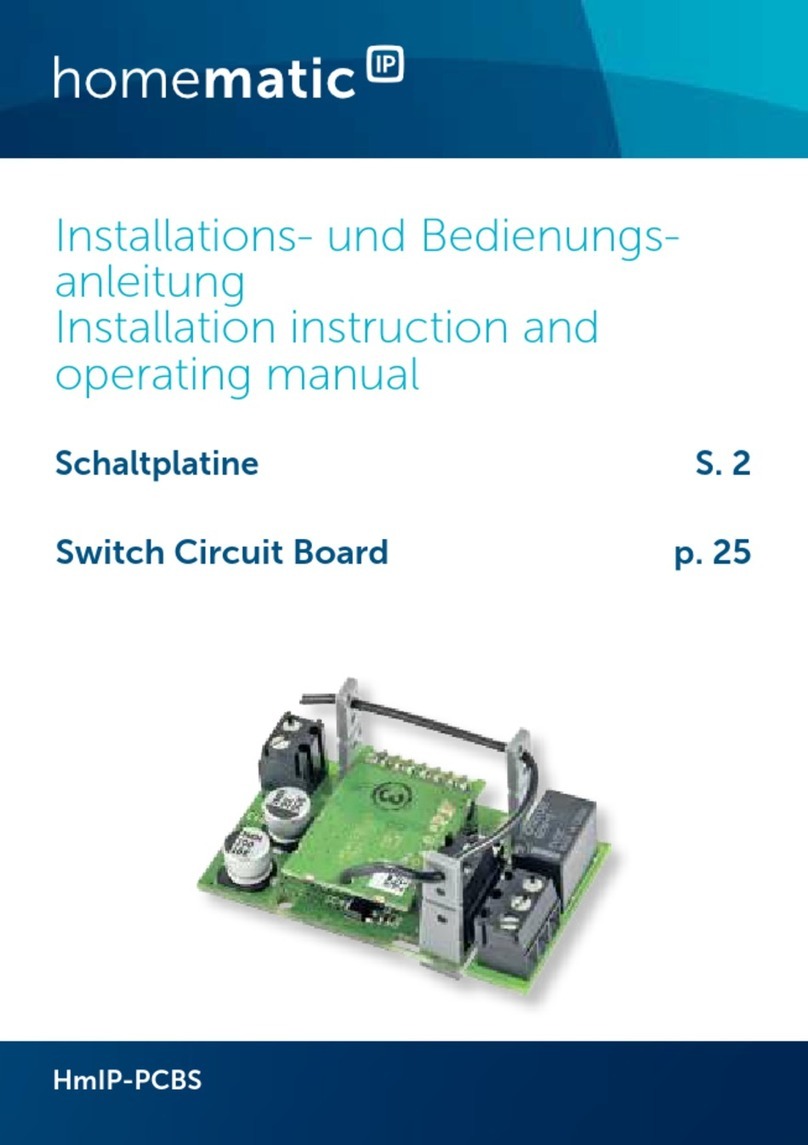
HomeMatic
HomeMatic HmIP-PCBS Installation instructions and operating manual
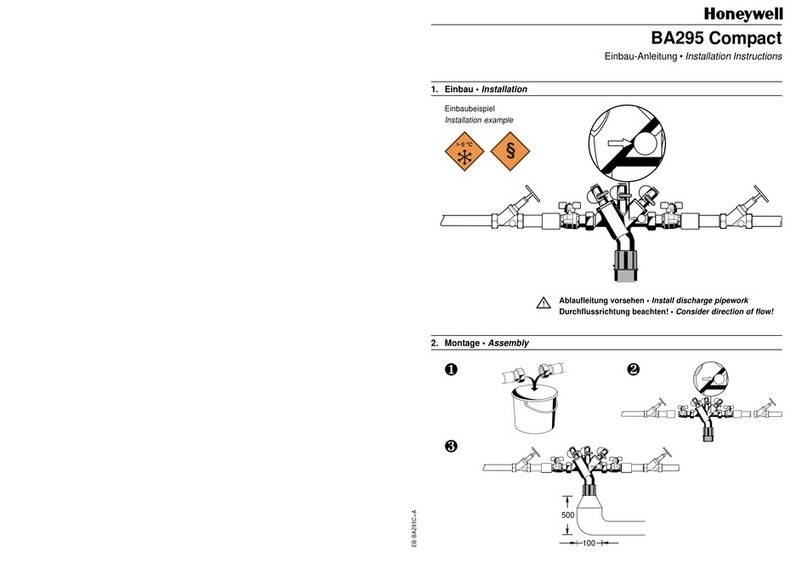
Honeywell
Honeywell BA295 Compact installation instructions
